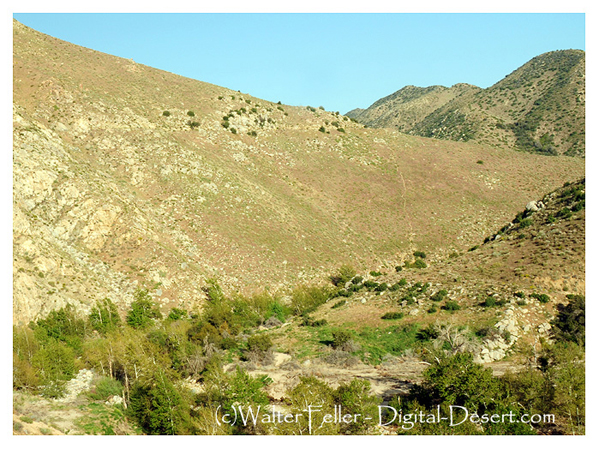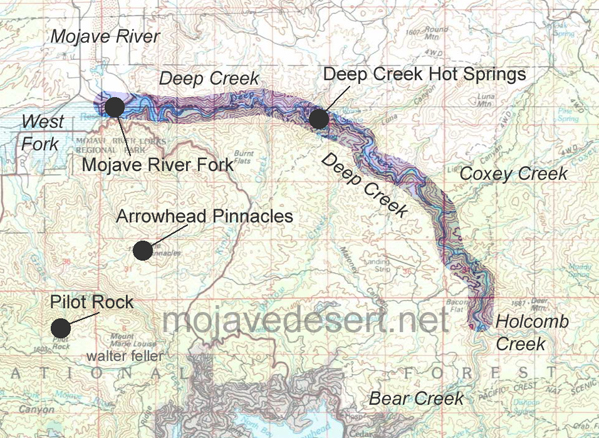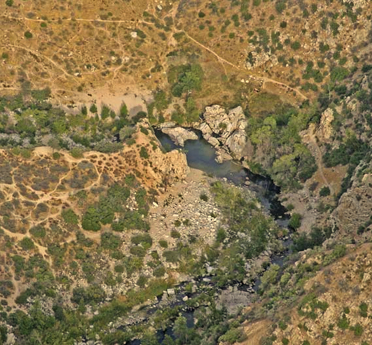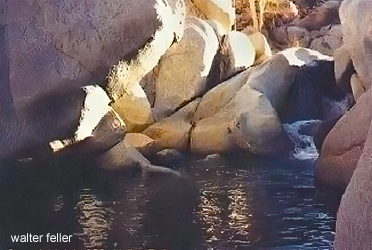Deep Creek
Located only 60 miles east of Los Angeles, Deep Creek flows through the San Bernardino Mountains to the East Mojave River, dropping approximately 3,000 feet through boulder-strewn reaches and deep pools. The river’s outstandingly remarkable values include its scenery, recreation, geology, fish, wildlife, cultural and botanical values.
Deep Creek has unique, diverse and spectacular scenery for southern California. The river travels through a remarkable life-zone journey of the San Bernardino Mountains, from conifer at higher elevations, mixed oak and pinyon-juniper woodlands at middle elevations, and chaparral- and grassland-covered hillsides. Lush green riparian vegetation dominates the view in the lower elevations. Along the way, the creek carves a rugged canyon, tumbling over granite cliffs and around gigantic boulders, and forms pools of clear water lined with willow, alder and cottonwood. Seasonal variations contribute to color changes seen throughout the hillsides and stream corridors, when the black oaks, willows and cottonwoods turn golden in the fall.

Direct access up and down the creek is generally by non-motorized trails. Premier fishing opportunities are found throughout the Deep Creek drainage. Sightseeing, swimming, picnicking, hiking, backpacking, angling and wildlife viewing opportunities abound. Deep Creek is a renowned regional freshwater fisheries resource, one of the finest in the forest and, in fact, southern California. It has been designated a state of California Wild Trout Program Stream. The most prominent geologic feature along Deep Creek is the thermal hot springs, a popular backpacker destination. Much of the upper portion of Holcomb Creek is the route of a popular off-highway vehicle trail. Further downstream, access is only by foot along the Pacific Crest National Scenic Trail, which follows the creek six miles through a truly wild canyon all the way to the confluence with Deep Creek and then continues from the confluence downstream along Deep Creek.
Deep Creek is home to nationally significant populations of endangered southwest willow flycatcher and arroyo toad. California spotted owls nest in nearby conifers and oaks, while golden eagles soar overhead. San Bernardino flying squirrels are also known to utilize Holcomb Creek. It is an area of high ecological significance supporting the greatest diversity of wildlife habitats of any drainage on the San Bernardino National Forest and serves as an important wildlife habitat linkage connecting endangered species in desert riparian habitats in the Mojave River to endangered species habitats in the mountains.
Deep Creek is also significant cultural pathway; the Vanyume Serrano Indians followed Deep Creek from their villages in the Mojave Desert to collect acorns and access other food sources in the mountains. Evidence of Native American use of the Deep Creek Canyon, especially for the last 2,000 years, is present in the river corridor, reflects all aspects of Native American life, and has exceptional human-interest value to the local Native American and Tribal community, as well as scientific value.
Deep Creek is considered to have outstandingly remarkable botanical values because it represents some of the greatest diversity of vegetation communities of any drainage on the San Bernardino National Forest. Fourteen vegetation communities representing transition zones from the mountains at 6,240 feet elevation, to the desert at 3,000 feet elevation, are present within the Deep Creek corridor. These vegetation communities also display a variety of successional stages that are both natural and human induced. Notable species include lemon lily and Humboldt lily, which occur at numerous locations along Deep Creek, and an historic population of the Mojave tarplant in the southern portion of Deep Creek. Holcomb Creek is considered to have outstandingly remarkable botanical values based on the regionally significant montane, wet meadow habitat and a large number of endemic, federally listed and U.S. Forest Service sensitive plants.
Source USFS
U.S. Forest Service
Designated Reach:
March 12, 2019. Deep Creek from 0.125 miles downstream of the Rainbow Dam site in Section 33, T 2 N, R 2 W, San Bernardino Meridian, to the upper limit of the Mojave Dam flood zone in Section 17, T 3 N, R 3 W, San Bernardino Meridian. Holcomb Creek from 100 yards downstream of the Road 3N12 crossing to the confluence with Deep Creek.
Classification/Mileage:
Wild — 22.5 miles; Scenic — 1.0 miles; Recreational — 11.0 miles; Total — 34.5 miles.
https://www.rivers.gov/rivers/deep-creek.php
Pacific Crest Trail
Hesperia Ditch
Lake Adelaide
Mojave River
Mojave River Fork
Atongai
Burnt Flats
State Highyway 173
Arrowhead Pinnacles
Summit Valley
West Fork


